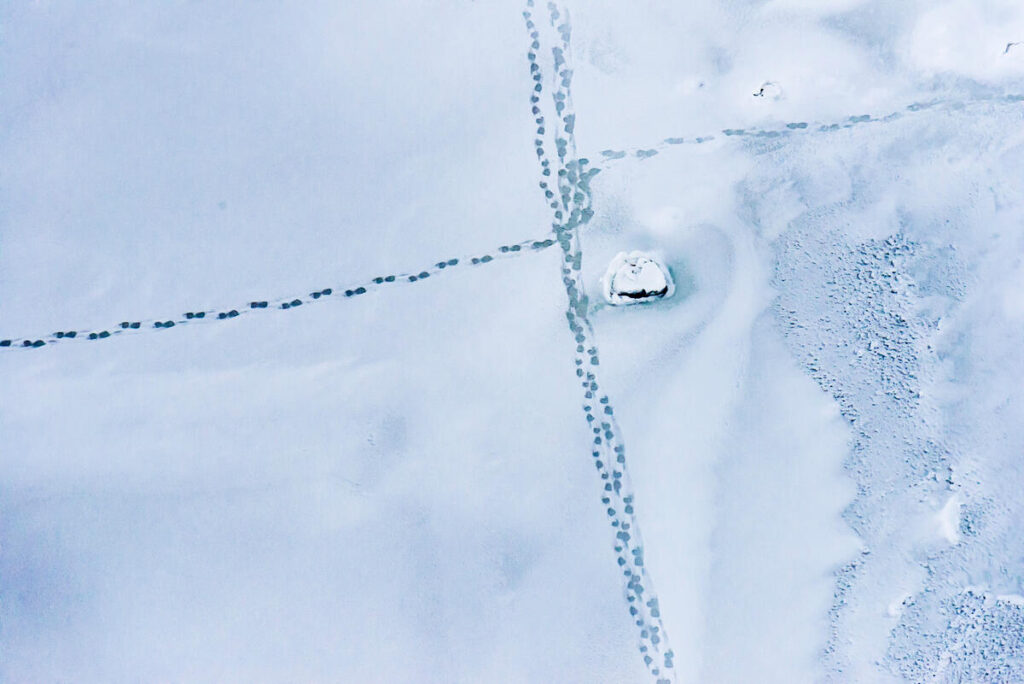© Stanislav / Adobe Stock
Polar bear threats
The biggest threat to polar bears’ survival is climate change – a warmer Arctic destroys the habitat polar bears need to survive. Climate change has also altered where polar bears live, how they obtain food.
© Max Oudgenoeg / WWF
How is climate change impacting polar bear habitats?
Human-caused greenhouse gas emissions are contributing to the loss and fragmentation of sea ice habitats.
Polar bears rely on sea ice habitats to hunt, live, breed, and in some cases, create maternal dens. But sea ice is more than a simple platform: it is an entire ecosystem inhabited by plankton and microorganisms. These organisms support a rich food chain, including nourishing seals, the most important source of food for polar bears.
There are different outcomes for polar bears depending on how the global community acts now and reduces greenhouse gas emissions.
A recent study shows that by 2100 it is likely that there will be local extinctions of polar bears from some parts of the Arctic — even if we moderately reduce our greenhouse gas emissions. If we fail to reduce our emissions, by 2100 we may lose all but a few high-Arctic subpopulations in and around the Last Ice Area.
How else are polar bears affected by climate change?
When polar bears’ sea ice habitat is not available, polar bears are forced to spend more time on land. There are knock-on effects for polar bears because there is less sea ice and the permafrost is melting.
Increased risk of sickness and disease for polar bears
Polar bears have adapted to live in the Arctic. However, as sea ice disappears polar bears are venturing beyond their normal range and are at risk of being exposed to diseases more common outside of the Arctic.
On top of that, scientists have found that the thawing of permafrost will likely release bacteria and viruses that have otherwise been locked in the frozen Arctic ecosystems. This means that polar bears are at risk of exposure to these viruses and diseases due to climate change.
Human activity and infrastructure can harm polar bears
Human and industrial activity is on the rise in the Arctic. Climate change has made the Arctic more accessible for industrial development, including mining and oil exploration. Increased human and industrial activities can disturb polar bears, their habitat and prey. Industrial activity also comes with the risk of exposing the habitat to toxins as well as waste management issues.
Having industrial activities in polar bear habitat also increases the risk that polar bears and humans will encounter each other – something that’s dangerous for both humans and polar bears.
© Naja Bertolt Jensen / Unsplash
Shipping activities can disturb polar bears
Between 2013 and 2023, shipping increased 37 per cent and the distance traveled doubled in the Arctic.
Increased shipping activity can impact polar bears in several ways, including:
- Increased pollution from ships, including heavy fuel oil.
- Underwater noise can disturb seals, polar bears’ main food source.
- Introduce waste, plastic pollution and invasive species from other locations.
All of these can disturb the fragile Arctic ecosystem that polar bears need to survive.
What is WWF doing to protect polar bears?
© Jon Aars / Norwegian Polar Institute / WWF-Canon
Protect essential habitat
WWF is working to protect essential polar bear habitats from harmful industrial activities, such as oil and gas exploration, and the evolving impact of climate change.
This includes safeguarding areas on land likely to become important in the future, and climate refuges where summer sea ice will last the longest, such as the Last Ice Area. It also includes advocating for networks of protected and conserved areas that will connect important habitats for both polar bears and their prey. ArcNet has already identified important areas.
Co-management of polar bear populations
WWF supports the co-management of polar bear populations by Indigenous Peoples’ Organizations and governments.
WWF is working towards coexistence between people and polar bears through local initiatives in Greenland, Canada and the US.
WWF is also working to safeguard 30 per cent of the Arctic Ocean by 2030 through projects to establish networks of Protected and Conserved Areas (PCAs) including Indigenous-led initiatives, and engaging in effective area-based conservation measures.
Melanie Lancaster, WWF Global Arctic Programme senior Arctic species specialist, collecting eDNA samples from polar bear footprints. Photo: © Micaela Hellström / WWF Arctic Programme
Support polar bear research
WWF supports research to understand how polar bears are responding to the climate crisis and contributes to the development of new technologies to enable monitoring.
This includes work done by local communities in many parts of the Arctic to keep people and polar bears safe by reducing conflict and working towards co-existence.
Here are a few examples of ways WWF supports polar bear research:
eDNA from polar bear tracks
WWF helped develop a new method that helps identify individual polar bears from the eDNA collected from a bear’s footprint in the snow. This pioneering approach enriches the conservation toolkit and can help scientists identify individual polar bears, understand population interconnection, and unravel migration patterns and behaviors.
Polar bear tracks in the WWF Wildlife Tracker
WWF supports polar bear researchers in their efforts to track polar bears. Researchers at Norwegian Polar Institute track polar bears in Svalbard, Norway and researchers at University of Manitoba track polar bears in Arctic Canada. Some of the polar bears being tracked can be seen on WWF’s Wildlife Tracker.
